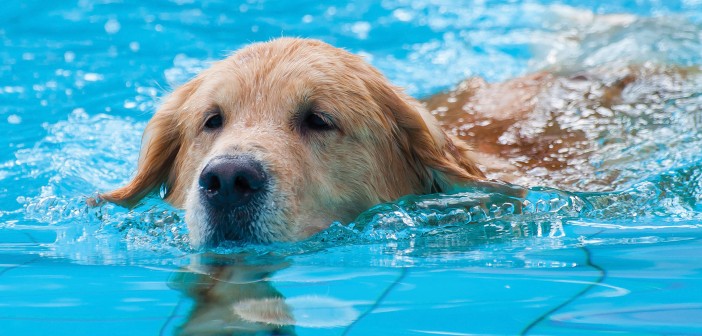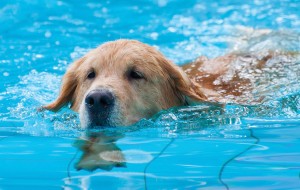by Lynn McCarron, DVM
Swimming for therapy has long been shown to have good benefits for humans for a variety of health reasons. More recently, our pets have begun to benefit as well. Exercising in water has many advantages over exercising on land, which include less pain, increased buoyancy, and increased stamina.
The effect of buoyancy allows for gentler exercise by decreasing the loads placed on injured tissues compared to land exercises. This results in less painful movements. Buoyancy also allows for improvement in joint mobility, and the extra support from floatation allows patients with significant muscle weakness to perform actions they could not do on land.
Interestingly, while the load on joints and muscles is less in water, exercising in water actually increases heart rate and oxygen higher than similar activity on land, and also uses more calories. Higher maximum exertion and respiratory rates in water verses on land makes it a good option for exercise in individuals with arthritis.
As our pets age, it becomes more important to keep them as comfortable and mobile as possible. Just as humans do, pets may develop a combination of arthritis, muscle weakness, or even nerve weakness. As arthritis pain develops, we find many of our pets are unable or unwilling to get as much exercise as they should, which then results in muscle weakness and loss of stamina. Hydrotherapy and water exercises are a great way to allow animals to maintain their muscle strength. Studies in humans show that benefits of hydrotherapy include not only increased fitness and increased heart strength and stamina, but also psychological well-being and quality of life.
Options for hydrotherapy for our pets may include swimming in lakes and streams, backyard swimming pools, canine recreation centers, and underwater treadmills. Underwater treadmills are actually well tolerated by most dogs, and are available through canine physical therapists. The dogs are slowly introduced to the water by the therapists, and are often supported with life-jackets and encouraged by treats. This modality is a great option for animals recovering from surgery or injuries, spinal cord diseases, or arthritis. Many pets who are unable to walk or even stand without help can learn to walk again in water.
There are many conditions for which aquatic therapy may be beneficial including broken bones, ACL repair and recovery, tendinitis, neurological conditions such as disk disease or nerve compression, and muscle disease. Cats will also benefit from hydrotherapy, if we are brave enough to try them. Smaller animals also suffer from arthritis and muscle weakness as much as their larger friends.
Hydrotherapy should be avoided in pets with open wounds or sutures. Animals with heart or lung disease should be carefully monitored. Animals who are not comfortable in water may panic and potentially injure themselves or the handler, so allowing them to slowly accommodate is advisable. Life-jackets are highly recommended for pets who may swim in pools or lakes to avoid tiring, and excessively cold water should be avoided with weaker pets.
Indoor heated swimming is available at Barley’s Canine Recreation Center, 2827 South 2300 East, Salt Lake City.
Underwater treadmill therapy is available with a licensed canine physical therapist at Utah Pet Rehab, 2896 East 3300 South, Salt Lake City.
Dr. McCarron is the owner of University Veterinary Hospital & Diagnostic Center in Salt Lake City. She is board certified, specializing in canine and feline practice, and a member of the American Association of Feline Practitioners. Dr. McCarron has enjoyed serving Wasatch Front pets for more than twenty years.





